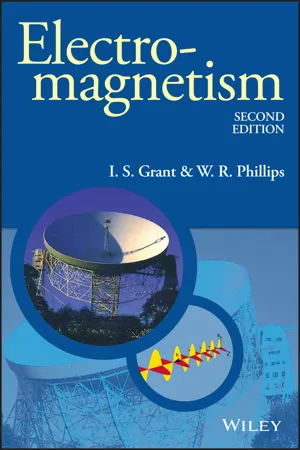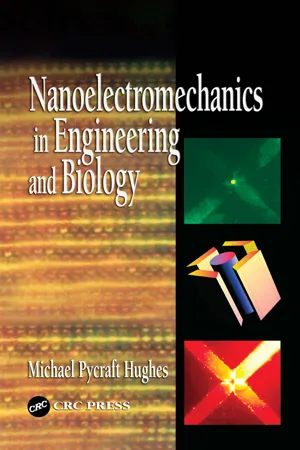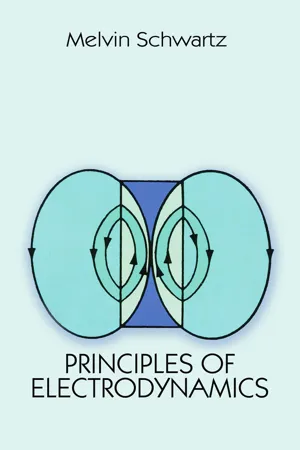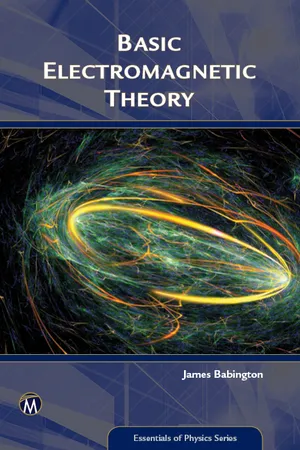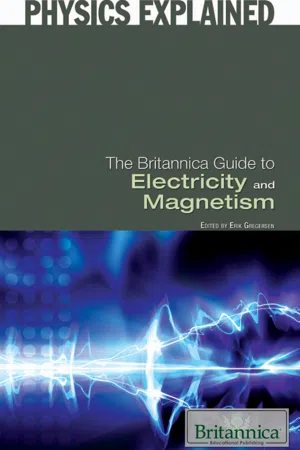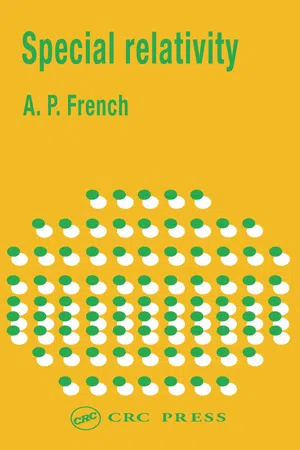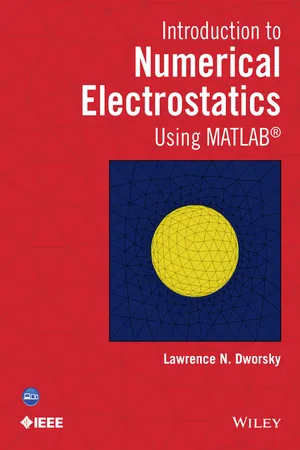Physics
Coulomb's Law
Coulomb's Law describes the electrostatic force between two charged particles. It states that the force is directly proportional to the product of the charges and inversely proportional to the square of the distance between them. Mathematically, it is expressed as F = k * (|q1 * q2|) / r^2, where F is the force, q1 and q2 are the charges, r is the distance between them, and k is the Coulomb's constant.
Written by Perlego with AI-assistance
Related key terms
Related key terms
1 of 4
Related key terms
1 of 3
12 Key excerpts on "Coulomb's Law"
- eBook - ePub
- I. S. Grant, W. R. Phillips(Authors)
- 2013(Publication Date)
- Wiley(Publisher)
CHAPTER 1
Force and energy in electrostatics
The only laws of force which are known with great precision are the two laws describing the gravitational forces between different masses and the electrical forces between different charges. When two masses or two charges are stationary, then in either case the force between them is inversely proportional to the square of their separation. These inverse square laws were discovered long ago: Newton’s law of gravitation was proposed in 1665, and Coulomb’s law of electrostatics in 1785. This chapter is concerned with the application of Coulomb’s law to systems containing any number of stationary charges. Before studying this topic in detail, it is worth pausing for a moment to consider the consequences of the law in the whole of physics.In order to make full use of our knowledge of a law of force, we must have a theory of mechanics, that is to say, a theory which describes the behaviour of an object under the action of a known force. Large objects which are moving at speeds small compared to the speed of light obey very closely the laws of classical Newtonian mechanics. For example, these laws and the gravitational force law together lead to accurate predictions of planetary motion. But classical mechanics does not apply at all to observations made on particles of atomic scale or on very fast-moving objects. Their behaviour can only be understood in terms of the ideas of quantum theory and of the special theory of relativity. These two theories have changed the framework of discussion in physics, and have made possible the spectacular advances of the twentieth century.It is remarkable that while mechanics has undergone drastic amendment, Coulomb’s law has stood unchanged. Although the behaviour of atoms does not fit the framework of the old mechanics, when the Coulomb force is used with the theories of relativity and quantum mechanics, atomic interactions are explained with great precision in every instance when an accurate comparison has been made between experiment and theory. In principle, atomic physics and solid state physics, and for that matter the whole of chemistry, can be derived from Coulomb’s law. It is not feasible to derive everything in this way, but it should be borne in mind that atoms make up the world around us, and that its rich variety and complexity are governed by electrical forces. - eBook - ePub
- Michael Pycraft Hughes(Author)
- 2018(Publication Date)
- CRC Press(Publisher)
polarity. The way that the charges interact with each other can influence this, even to the extent of inducing dipoles where none existed previously. In order to examine this we must look at the fundamental aspects governing electrostatics, beginning with Coulomb’s law.2.2 Coulomb’s law, electric field, and electrostatic potentialAs stated above, there is an attraction between opposing charge signs and a repulsion between like charges. In 1785, the French scientist Charles-Augustin de Coulomb (after whom the unit of charge is named) determined that the magnitude and direction of this force was proportional to the product of the magnitudes of the two charges multiplied together, inversely proportional to the square of the distance between them, and acts along the vector running through the centers of the charges. Subsequent work has demonstrated that the force can be expressed mathematically asF =rQ 1Q 24 πε 0d 2(2.1) where Q1 and Q2 are the two charges, d the distance between them, r is the unit vector directed from Q1 to Q2 , (as illustrated in Figure 2.1 ), and ε is the permittivity of the space between the charges; this is a quantity that describes the way in which charges relate to one another through space. The permittivity of free space, ε0 , has the value 8.85 × 10–12 Farads per meter (F m–1 ). The presence of matter between the charges increases the permittivity, as we will see in the next section.Figure 2.1 Two charges, a distance d apart along vector r, will experience a force in accordance with Coulomb’s law. This force acts along vector r and is repulsive when the charges are alike (as in the example here) or attractive when the charges are unalike.While Equation 2.1 is undoubtedly useful, it can only be applied successfully to combinations of two charges. In order to deal with large ensembles of charges, we need to introduce another concept. Since each charge (let us say, Q1 ) can be said to exert an influence on all other charges in proportion to the magnitude of this charge and the other charge, we can split Equation 2.1 into the contribution of charge Q1 — which remains constant, regardless of the other charges present — and the contribution of other charges, which gives us the total value of force. Effectively, Q1 produces a force field that can be plotted across space in the absence of any other charges, and it is the interaction with that force field that produces the electrostatic force. This force field is called the electric field, and can be defined such that Equation 2.1 - eBook - ePub
- Melvin Schwartz(Author)
- 2012(Publication Date)
- Dover Publications(Publisher)
2Principles of Electrostatics2-1INTRODUCTION; COULOMB’S LAWOur study of electromagnetism begins very simply with Coulomb’s law. In the chapters ahead as we examine the beautiful structure of Maxwell’s equations, we must try to remember that it all began as a law of force governing the interaction of two charged particles. It will be amazing to see how much ground we can cover on this one tank of fuel.As we all know, there is an attribute which exists in matter and which we have come to call electric charge. Some objects may have positive charge and some negative. Once a standard charge sign has been chosen, all other charges can be classified in sign by whether they are attracted to or repelled by the standard charge. Having done this, we observe that all pairs of charges with like sign repel one another and all pairs with unlike sign attract one another. This pseudosexual rule can be codified quantitatively by observing that the force of one charge on another is proportional in magnitude to the product of the charges and inversely proportional to the square of their separation. We then write down Coulomb’s law.F12 = force by charge 1 on charge 2Of course we must set up a system of units, and we do so in the most natural way possible. We let distance be measured in centimeters and force in dynes. Equation (2-1-1) then serves to define the unit of charge, which we call the esu (electrostatic unit). Thus two equal charges, each of one electrostatic unit, will pull (or push) on each other with a force of one dyne if they are set one centimeter apart.If we have a number of charges around, then the force on each by all the others can be obtained by simply adding the individual forces vectorially. If q1 , q2 , …, qn are a set of charges at positions r1 , r2 ,. . ., rn , respectively, then the force on qi isWe now introduce the notion of electric field. Having set our charges q1 , q2 , ..., qn into their positions r1 , ..., rn , we can place a very small charge at position r = (x, y, z). We then measure the force per unit charge on q in the limit as q approaches zero. (The limiting procedure is carried out to avoid disturbing the other charges.) The result is the electric field E at (x, y, z - Nima Gharib, Javad Farrokhi Derakhshandeh, Peter Radziszewski(Authors)
- 2022(Publication Date)
- Elsevier(Publisher)
Coulomb's Law and electric field 3.1. Coulomb's Law The basic electromagnetic concepts are studied one by one in sequence. A dimensional description will suffice in the vast majority of cases; the latter will be deduced from their relationship via the theory's basic equations, which will be tested experimentally. The next section will take place immediately after the current enumeration of essential concepts. To understand how much force does a single point charge q exert on a test charge Q while it is at rest r distance away, Coulomb's Law can evaluate the answer as follows: (3.1) The constant ε 0 = (8.85 × 10 − 12 C 2 /N m 2) is referred to as open space permittivity (ludicrously). In SI units, newton (N) denotes force, meter (m) denotes distance, and coulomb denotes charge (C). In other words, the force is proportional to the charge product and inversely proportional to the square of the separation distance. Here, item Δ r is the separation vector with magnitude of r. The force is directed down the line q-Q ; it is repulsive if q and Q have the same sign, and attractive if they have the opposite sign. Coulomb's Law and the principle of superposition provide the physical basis for electrostatics; all else is mathematical development of these basic laws, with the exception of a few specific features and elaboration these rules. 3.2. The electric field If there are many point charges, such as q 1, q 2, …, q n at distances r 1, r 2, …, r n from Q, the total force on Q is then equal to (3.2) or (3.3) Here, (3.4) Factor E (r) is referred to as the source of electric field charge, which is a function of position (r), since the separation vectors r i are location-dependent. However, it makes no mention of the test charge Q. The electric field is a vector quantity that varies across points and is governed by the arrangement of source charges as shown in Fig. 3.1 ; physically, E (r) is the force per unit charge that would be exerted on a test charge if placed at P. 4- No longer available |Learn more
- Robert A. Pelcovits, Joshua Farkas(Authors)
- 2023(Publication Date)
- Barrons Educational Services(Publisher)
10Electrostatics
Learning Objectives
In this chapter, you will learn:Coulomb’s lawPrinciple of superpositionElectric fields and field linesElectric potential and voltageCalculating the potential due to a continuous charge distributionFinding the electric field given the potentialCalculating the electric field due to a continuous charge distributionWe begin our study of electric and magnetic phenomena by considering the interaction of stationary point electric charges. This is easy to do if we go back to Chapter 9 and replace the words gravitational force with electric force, and mass with charge. That’s right—the physics and math behind stationary point electric charges and universal gravitation are just about the same, with the exception that in gravitation there are no repulsive forces.Coulomb’s Law
The magnitude of the force between two point charges Q1 and Q2 separated by a distance R is given by the equationScalar part of Coulomb’s lawTIPNote the similarity with Newton’s law of universal gravitation, Chapter 9 .The direction of the force is along the line between the two charges. Like charges repel, while unlike charges attract.Coulomb’s law, like Newton’s law of universal gravitation, is an experimental result. However, it does make sense that the force increases with increasing charges and decreases with increasing distance between charges.ε0 is a constant called the permittivity of free space and is given ε0 = 8.85 × 10− 12 C2 /N · m2 . From your physics class, you may also be familiar with Coulomb’s law written in the form F = k|Q1 Q2 |/R2 , where k is called the electrostatic constant and has a value of k = 1/4πε0 = 8.99 × 109 N · m2 /C2 . ε0 - eBook - ePub
Molecular Driving Forces
Statistical Thermodynamics in Biology, Chemistry, Physics, and Nanoscience
- Ken Dill, Sarina Bromberg(Authors)
- 2010(Publication Date)
- Garland Science(Publisher)
20 Coulomb’s Law of Electrostatic Forces Charge Interactions Are Described by Coulomb’s LawElectrical interactions between charges govern much of physics, chemistry, and biology. They are the basis for chemical bonding, weak and strong. Salts dissolve in water to form the solutions of charged ions that cover three-quarters of the Earth’s surface. Salt water forms the working fluid of living cells. pH and salts regulate the associations of proteins, DNA, cells, and colloids, and the conformations of biopolymers. Nervous systems would not function without ion fluxes. Electrostatic interactions are also important in batteries, corrosion, and electroplating.Charge interactions obey Coulomb’s law. When more than two charged particles interact, the energies are sums of Coulombic interactions. To calculate such sums, we introduce the concepts of the electric field, Gauss’s law, and the electrostatic potential. With these tools, you can determine the electrostatic force exerted by one charged object on another, as when an ion interacts with a protein, DNA molecule, or membrane, or when a charged polymer changes conformation.Coulomb’s law was discovered in careful experiments by H Cavendish (1731–1810), J Priestley (1733–1804), and CA Coulomb (1736–1806) on macroscopic objects such as magnets, glass rods, charged spheres, and silk cloths. Coulomb’s law applies to a wide range of size scales, including atoms, molecules, and biological cells. It states that the interaction energy u(r) between two charges in a vacuum isu( r )=,Crq 1q 2(20.1) where q1 and q2 are the magnitudes of the two charges, r is the distance separating them, andC = 1 / 4 πis a proportionality constant (see box below).ε 0UnitsThe proportionality constant C in Equation (20.1) depends on the units used to measure the charge and the distance. In the older c.g.s. system, the units were defined so thatC = 1. We use the SI system, in which the unit of charge is the coulomb C, the unit of energy is the joule J, and the unit of distance is the meter m. The corresponding constant C equals (4πε0 )−1 . The factor ε0 is called the permittivity of the vacuum. In SI units, ε0 = 8.85 × 10−12 Fm−1 . The farad F is the SI unit of capacitance, equal to 1 C V−1 . The volt V is the SI unit of electrical potential, which is equal to 1 JC−1 . So ε0 = 8.85 × 10−12 C2 J−1 m−1 . In c.g.s. units, the unit of charge is 1 statcoulomb or 1 esu = 3.00 × 109 C, the unit of potential is 1 statvolt = (1/300) V, and the unit of capacitance is 1 statfarad = 9 × 1011 - eBook - ePub
Introduction to Electromagnetism
From Coulomb to Maxwell
- Martin J N Sibley(Author)
- 2021(Publication Date)
- CRC Press(Publisher)
2 Electrostatic FieldsMost of us are familiar with the phenomenon of electrostatic discharge: lightning strikes, sparks from nylon clothing and sparks from nylon carpet. It may be thought that the study of static electric fields has little to offer the electrical engineer. After all, we are taught that electrons flow in conducting materials, and so why should we concern ourselves with the study of static charges? However, as we shall see later in this chapter, electrostatics introduces several ideas that will be very helpful when we consider capacitors and, ultimately, transmission lines.2.1 Coulomb’s Law
As we have seen in Chapter 1 , electronic charge comes in two forms: negative charge from an electron and positive charge from a proton. In both cases, a single isolated charge has a charge of 1.6 × 10−19 Coulomb. If there are two charges close to each other, they tend to repel each other if the charges are alike or attract each other if they are dissimilar. Thus, we can say that these charges exert a force on each other.Charles Augustin de Coulomb (1736–1806) determined by direct experimental observation that the force between two charges is proportional to the product of the two charges and inversely proportional to the square of the distance between them. In terms of the SI units, the force between two charges, a vector quantity, is given bywhereF =(2.1)rq 1q 24 π εr 2- F is the force between the charges (N)
- q 1 and q 2 are the magnitudes of the two charges (C) ε is a material constant (F m−1 )
- r is the distance between the charges (m)
- and r is a unit vector acting in the direction of the line joining the two charges – the radial unit vector
This is Coulomb’s law. The force, as given by Equation (2.1), is positive (i.e. repulsive) if the charges are alike, and negative (i.e. attractive) if the charges are dissimilar (see Figure 2.1 ). As Equation (2.1) shows, the force between the charges is inversely dependent on a material constant, ε - eBook - ePub
- James Babington(Author)
- 2016(Publication Date)
- Mercury Learning and Information(Publisher)
J is given by(3.1) A constant of proportionality has been introduced and we need to think about the units of measure and how more generally we should measure the electric charge on a body. In fact this turns out to be a subtle issue because we will in addition need to introduce a dynamical element. Clearly, both the observed forces and separations are honest to goodness measurable quantities. If we can identify the correct symmetry in a problem that has been setup with this in mind, we will be able find the ratio of the charges. But ultimately the observed forces will have to be made with respect to the undetermined constant which is called the permittivity of free space. If charge was infinitely divisible we would need to define a basic unit, whereas if (as is the actual case for electrons and protons) it is found to have a minimum discrete unit, we can use this as our basic natural unit of charge. The upshot is that, at this point, we will not ascribe to a particular number and return to its numerical value later on.A natural question to ask is what is the effect of a number of charged bodies on one another. Let us do another experiment.Experiment 3 Suppose we introduce other electrically charged bodies in addition to the previous two already considered. What is the effect on one of the bodies?Observation 3 (The principle of linear superposition) After this introduction and a long enough time for all the bodies to settle down, the resultant force on the body is the vector sum due to all the other bodies.In connection with this principle, it is useful to introduce the idea of a test charge - eBook - ePub
- A. L. Stanford, J. M. Tanner(Authors)
- 2014(Publication Date)
- Academic Press(Publisher)
11Electric Charge and Electric Fields
Publisher Summary
This chapter begins our study of electric and magnetic phenomena, collectively called electromagnetism . Electromagnetic forces, like gravitational forces, are fundamental interactions that occur between particles. Just as mass is that property of matter that engenders gravitational attraction, electric charge is a property of certain fundamental particles, like electrons and protons, that causes electromagnetic interaction. Our investigation of electrostatics , the analysis of interactions between charges at rest, is based on a force law for charges and on the concept of electric fields. The force law for charges, called Coulomb’s law, is the electrical analogue of the law of universal gravitation. The electric field is an abstract concept used to characterize how the presence of charge alters the properties of the space around that charge.11.1 Electric Charge and Coulomb’s Law
Electric charges exist in two forms, called positive charge and negative charge . The natural unit of charge is the positive charge of a proton or the negative charge of an electron. The SI unit of charge is the coulomb (C), which will be defined later in terms of electric current. This unusual definition is used because of the difficulty of making reproducible measurements on quantities of charge. For now, we will use as a measure of charge the experimentally obtained value for e , the magnitude of the charge of an electron or proton:e = 1.60 ×(11-1)10C− 19(11-1)Equivalently, a coulomb is the quantity of charge carried by 6.25 × 1018 electrons.An electron (or proton) bears the smallest unit of charge found in nature, so any quantity of charge q occurs as an integral number n of the basic charge e , or q = ne . Thus, as with any physical quantity made up of a number of “minimum parcels,” we say that electric charge is quantized; the least quantity that occurs, the quantum of charge, is the electronic charge e - Britannica Educational Publishing, Erik Gregersen(Authors)
- 2010(Publication Date)
- Britannica Educational Publishing(Publisher)
Many of these devices and phenomena are complex, but they derive from the same fundamental laws of electromagnetism. One of the most important of these is Coulomb’s law, which describes the electric force between charged objects. Formulated by the 18th-century French physicist Charles-Augustin de Coulomb, it is analogous to Newton’s law for the gravitational force. Both gravitational and electric forces decrease with the square of the distance between the objects, and both forces act along a line between them. In Coulomb’s law, however, the magnitude and sign of the electric force are determined by the charge, rather than the mass, of an object. Thus, charge determines how electromagnetism influences the motion of charged objects. (Charge is a basic property of matter. Every constituent of matter has an electric charge with a value that can be positive, negative, or zero. For example, electrons are negatively charged, and atomic nuclei are positively charged. Most bulk matter has an equal amount of positive and negative charge and thus has zero net charge.)According to Coulomb, the electric force for charges at rest has the following properties: (1) Like charges repel each other; unlike charges attract. Thus, two negative charges repel one another, while a positive charge attracts a negative charge. (2) The attraction or repulsion acts along the line between the two charges.(3) The size of the force varies inversely as the square of the distance between the two charges. Therefore, if the distance between the two charges is doubled, the attraction or repulsion becomes weaker, decreasing to one-fourth of the original value. If the charges come 10 times closer, the size of the force increases by a factor of 100.(4) The size of the force is proportional to the value of each charge. The unit used to measure charge is the coulomb (C). If there were two positive charges, one of 0.1 coulomb and the second of 0.2 coulomb, they would repel each other with a force that depends on the product 0.2 × 0.1. If each of the charges were reduced by one-half, the repulsion would be reduced to one-quarter of its former value.The electric force is operative between charges down to distances of at least 10-16- eBook - ePub
- A.P. French(Author)
- 2017(Publication Date)
- CRC Press(Publisher)
2 . Hence the magnitude of the force on this length of wire is given byF =i.e.,λ 2lv 2()2 kI 1c 2bThis force, as we have seen, is in the plane of the wires. If the currents are in the same direction, the force is attractive. If the currents are oppositely directed, the force is repulsive.F =2 kc 2l =bI 1I 2B 2I 2l( 8-20 )The constant k , remember, is the constant of proportionality in Coulomb’s law. We see now that it appears in the expression for the force between two current-carrying wires and can therefore be used to calculate that force when known currents are flowing. In the MKS system, as we mentioned at the beginning of the chapter, its value is about 9 × 109 newton • m2 /coulomb2 . Using Eq. (8-20) , one can calculate from this that the force per unit length between two parallel wires, 1 cm apart, each carrying a current of 10 amp, is 0.002 newton/m. If there were no positive ions to neutralize the electric field of the electrons, the electric force between the wires would be a factor of c 2 /v 2 greater than this, or about 5 × 1020 newton/m!Units And Systems of Electric and Magnetic Measurement
To wrap up this discussion, as it were, let us return to the quantitative statements of the electric and magnetic force laws with which we began the chapter. The subject of basic units, etc., may often seem rather dull, but the unification of electricity and magnetism through relativity provides a special interest in this case.Equation (8-1) states the basic law of force between electric charges (Coulomb’s law). The last equation [Eq. (8-20) ] states a law of force between parallel currents. The CGS unit of charge was defined by setting the constant k equal to unity in the Coulomb law. But what if we let Eq. (8-20) define our unit of charge? We can do this by asserting that two parallel wires, placed a unit distance apart and each carrying a current of unit strength, repel or attract one another with exactly 2 units of force per unit length. Why 2 units of force and not 1? To correspond with the factor 2 on the right side of Eq. (8-20) . Historically, this was in effect done to define an absolute unit of current, and the units of mechanical measurement were CGS units.1 - Lawrence N. Dworsky(Author)
- 2014(Publication Date)
- Wiley-IEEE Press(Publisher)
The materials to follow are intended to be a quick review of the relationships that will be used throughout this book. The intent here is to provide a consistent set of notation using all the relationships that will be needed going forward. Many of these relationships are stated without derivation or proof. A more complete electrostatics theory text is recommended for newcomers to the subject. There are very many excellent texts available. The references list at the end of this chapter is certainly not exhaustive, but the texts cited are considered standards in the field.1.1 Charge, Force, and the Electric Field
Electric charges exert forces on one another. This is the basis of electrostatics. The characteristics of these forces are summarized in Coulomb’s law:- Electric charge carries a polarity, or sign. The choice of sign was originally arbitrary, but now is established by tradition—the electron, the most common charged subatomic particle, carries a negative charge.
- For point charges q1 and q2 , measured in coulombs, the (coulomb) force, measured in newtons, in a uniform medium, is given by
(1.1 )
- In equation (1.1 ) and elsewhere ε is the permittivity of the material in farads per meter (F/m). In free space, ε = ε0 = 8.854 F/m. For other linear, isotropic, homogeneous materials, ε = kε0 , where k is the relative permittivity, the relative dielectric constant, or sometimes simply the dielectric constant, of the material. Farads per se are defined as coulombs per volt (C/V). In this book we shall consider only linear, isotropic, homogeneous dielectric materials, and going forward this will be assumed.
- In equation (1.1 ) r is the distance between q 1 and q 2 .
- Also, is a unit vector along the line connecting q 1 and q 2 . If q 1 and q 2 have the same sign, then is pushing q 1 and q 2 apart. If q 1 and q 2 have opposite signs, is pulling them together.
Equation (1.1 ) is expressed in the rationalized meter-kilogram-second (mks) system of units. The derivation of this set of units is an interesting discussion in itself.2When a test charge is in the area of a collection of charges and the magnitude of these latter charges is sufficient, relative to the test charge, to render negligible any perturbation of the situation due to the test charge, then the force on the test charge divided by its charge is defined to be the electric field at that point (typically called the field point). The electric field at (the field point) p due to a charge q
Index pages curate the most relevant extracts from our library of academic textbooks. They’ve been created using an in-house natural language model (NLM), each adding context and meaning to key research topics.
Explore more topic indexes
Explore more topic indexes
1 of 6
Explore more topic indexes
1 of 4
